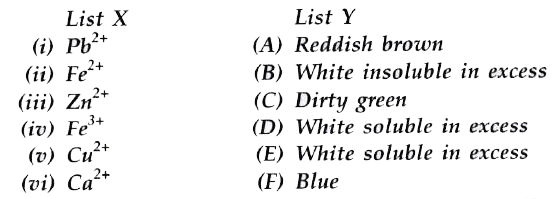From the solution containing copper (+2) and zinc (+2) ions copper can be selectively precipitate using sodium sulphide.
The correct Answer is:T
To selectively precipitate copper ions from a solution containing both copper (Cu²⁺) and zinc (Zn²⁺) ions using sodium sulfide (Na₂S), we can follow these steps:
1. Understanding the Ion Composition:
- The solution contains copper ions (Cu²⁺) and zinc ions (Zn²⁺). Both are cations, but they belong to different groups in qualitative analysis.
2. Identifying the Group of Cations:
- Copper (Cu²⁺) is classified as a group II cation, while zinc (Zn²⁺) is classified as a group III cation. This classification helps in understanding how to selectively precipitate them.
3. Using Sodium Sulfide:
- Sodium sulfide (Na₂S) is the reagent used for precipitation. When added to the solution, it dissociates into sodium ions (Na⁺) and sulfide ions (S²⁻).
4. Precipitation Reaction:
- The sulfide ions (S²⁻) react with copper ions (Cu²⁺) to form copper(II) sulfide (CuS), which is a black precipitate:
Cu2++S2−→CuS (s)
- Zinc ions (Zn²⁺) also react with sulfide ions to form zinc sulfide (ZnS), which is a white precipitate:
Zn2++S2−→ZnS (s)
5. Comparing Solubility Products (Ksp):
- The key to selectively precipitating copper over zinc lies in the solubility products (Ksp) of their sulfides. The Ksp of CuS is much lower than that of ZnS, meaning CuS is less soluble and will precipitate first when sodium sulfide is added.
6. Conclusion:
- Since CuS precipitates before ZnS due to its lower Ksp, we can conclude that copper can be selectively precipitated from the solution using sodium sulfide. Therefore, the statement is true.
Final Answer:
The statement that copper can be selectively precipitated from a solution containing copper and zinc ions using sodium sulfide is True.
---
- The solution contains copper ions (Cu²⁺) and zinc ions (Zn²⁺). Both are cations, but they belong to different groups in qualitative analysis.
- Copper (Cu²⁺) is classified as a group II cation, while zinc (Zn²⁺) is classified as a group III cation. This classification helps in understanding how to selectively precipitate them.
- Sodium sulfide (Na₂S) is the reagent used for precipitation. When added to the solution, it dissociates into sodium ions (Na⁺) and sulfide ions (S²⁻).
- The sulfide ions (S²⁻) react with copper ions (Cu²⁺) to form copper(II) sulfide (CuS), which is a black precipitate:
Cu2++S2−→CuS (s)
- Zinc ions (Zn²⁺) also react with sulfide ions to form zinc sulfide (ZnS), which is a white precipitate:
Zn2++S2−→ZnS (s)
- The key to selectively precipitating copper over zinc lies in the solubility products (Ksp) of their sulfides. The Ksp of CuS is much lower than that of ZnS, meaning CuS is less soluble and will precipitate first when sodium sulfide is added.
- Since CuS precipitates before ZnS due to its lower Ksp, we can conclude that copper can be selectively precipitated from the solution using sodium sulfide. Therefore, the statement is true.
The statement that copper can be selectively precipitated from a solution containing copper and zinc ions using sodium sulfide is True.
Topper's Solved these Questions
- QUALITATIVE INORGANIC SALT ANALYSISBook:CENGAGE CHEMISTRY ENGLISHChapter:QUALITATIVE INORGANIC SALT ANALYSISExercise:Exercises Archives (Subjective)
Explore 34 Videos
- QUALITATIVE INORGANIC SALT ANALYSISBook:CENGAGE CHEMISTRY ENGLISHChapter:QUALITATIVE INORGANIC SALT ANALYSISExercise:Ex 8.1
Explore 14 Videos
- QUALITATIVE INORGANIC SALT ANALYSISBook:CENGAGE CHEMISTRY ENGLISHChapter:QUALITATIVE INORGANIC SALT ANALYSISExercise:Exercises Archives (Fill In The Blanks Ype)
Explore 2 Videos
- P-BLOCK GROUP 18 ELEMENTS - THE INERT GASESBook:CENGAGE CHEMISTRY ENGLISHChapter:P-BLOCK GROUP 18 ELEMENTS - THE INERT GASESExercise:Ex 5.1 (Objective)
Explore 14 Videos
- REDUCTION AND OXIDATION REACTION OF ORGANIC COMPOUNDSBook:CENGAGE CHEMISTRY ENGLISHChapter:REDUCTION AND OXIDATION REACTION OF ORGANIC COMPOUNDSExercise:SUBJECTIVE TYPE
Explore 4 Videos
Similar Questions
Knowledge Check
When zinc granule is dipped into copper sulphate solution, copper is precipitated because :
ABoth, copper and zinc have a positive reduction potential.BReduction potential of copper is higher than that of zinc.CReduction potential of zinc is higher than that of copper.DBoth, zinc and copper have a negative reduction potential.Sulphide ore of copper can be concentrated by
A(A)Forth flotation processB(B)electromagnetic processC(C)gravity separationD(D)distillationWhen a copper wire is dipped into silver nitrate solution, silver is precipitated because
Aboth silver and copper have positive reduction potentialsBreduction potential of silver is higher than that of copperCreduction potential of copper is higher than that of silverDboth silver and copper have negative reduction potentials.
The addition of ammonium chloride to a solution containing ferric and magnesium ions is essential for selective precipitation of ferric hydroxide by aqueous ammonia.
View SolutionSodium hydroxide solutions to the solutions containing the ions mentioned in list x list y gives the detail of the precipitate match the ions their coloured precipitates

View SolutionBlack precipitate of copper sulphide dissolves in:
View SolutionUpon treatment with ammonical H2S solution, the metal ion precipitating as sulphide is:
View SolutionCopper can be extracted by hydrometallurgy but not zinc because
View Solution